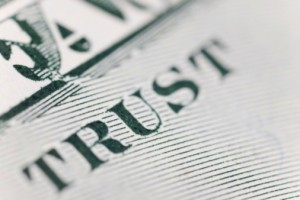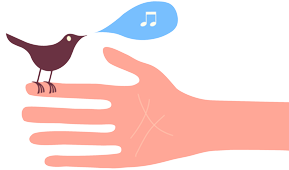 Do you keep trusting people only to have your trust betrayed? Do people take advantage of you?
Do you keep trusting people only to have your trust betrayed? Do people take advantage of you?
Or do you find it difficult to trust anyone and prefer to rely only on yourself? Do people think you are paranoid or too suspicious?
If the answer to any of those questions is “yes”, you probably never learned how to know whether others can be trusted. Here is one way to learn.
Imagine that for every relationship there is a “trust fund”. Both people in the relationship can make deposits and withdrawals.
A trust fund “deposit” is when someone in the relationship does something to increase trust. Example: A friend follows through on a commitment to make you a meal when you are sick.
A trust fund “withdrawal” is when someone in the relationship does something to decrease trust. Example: A friend forgets about a commitment made to you and does not follow through.
If there is plenty of trust accumulated in the “fund,” then a relationship can withstand a large withdrawal. For example, if a couple has been together for 30 years and has a fairly healthy relationship, the couple can probably handle even a major argument because there is a lot of trust built up. In contrast, if a couple has just started dating, a major argument can destroy the relationship because there isn’t enough trust yet for the couple to weather the storm of the fight.
When you aren’t sure whether you can trust someone, it is helpful to think carefully about what is in your “trust fund.” What deposits has the other person made? What withdrawals? I find it useful sometimes to put a “dollar value” on what is in the “fund.” So if you have a friend you’ve only known for a few weeks, you might think: “At this point, we probably have only $50 in our trust fund because we haven’t known each other for very long.”
Then put a “dollar value” on the level of risk you would be taking in trusting the person to do something. For example, if a friend asks to borrow a book from you, you might decide that is fairly low-risk — perhaps a $5 risk that the friend won’t return your book (more if it’s your favorite book, less if you don’t care about the book). If there is $50 in your “fund” and it’s a $5 risk, there is enough trust in your relationship to lend your friend the book. If you are someone who has a problem trusting others, you can use this process to reassure yourself that it is safe to take this risk.
However, if that same friend asks if he can move in with you temporarily until he finds another place to live, that is a much bigger risk. If things go badly, you could get hurt physically, financially, or emotionally. So perhaps that is more of a $500 risk. In that case, you really don’t have enough in your $50 trust fund to allow you to risk that loss. And it isn’t reasonable for people to expect you to give them more trust than your relationship has accumulated.
People who have learned how to judge the trustworthiness of others have already internalized this basic assessment process. They don’t need to think about the risk and the “dollar values” so explicitly; their reactions usually tell them when they can trust someone or not. But if you are someone whose trust was betrayed a lot in your life, who tends to trust too much or too little, a process to help assess the level of trust and risk is valuable until you have enough experience to internalize the process yourself.
There is a “trust fund” in a therapy relationship also. As a therapist, I don’t think it’s reasonable to expect new clients to trust me enough to open up completely and make themselves too vulnerable. In a first session, a client cannot possibly know that I am trustworthy yet. I encourage clients to take their time, to wait until they know they can trust me before they disclose their deepest, darkest secrets. It is important to respect the “trust fund” and not risk losing it all too soon.
